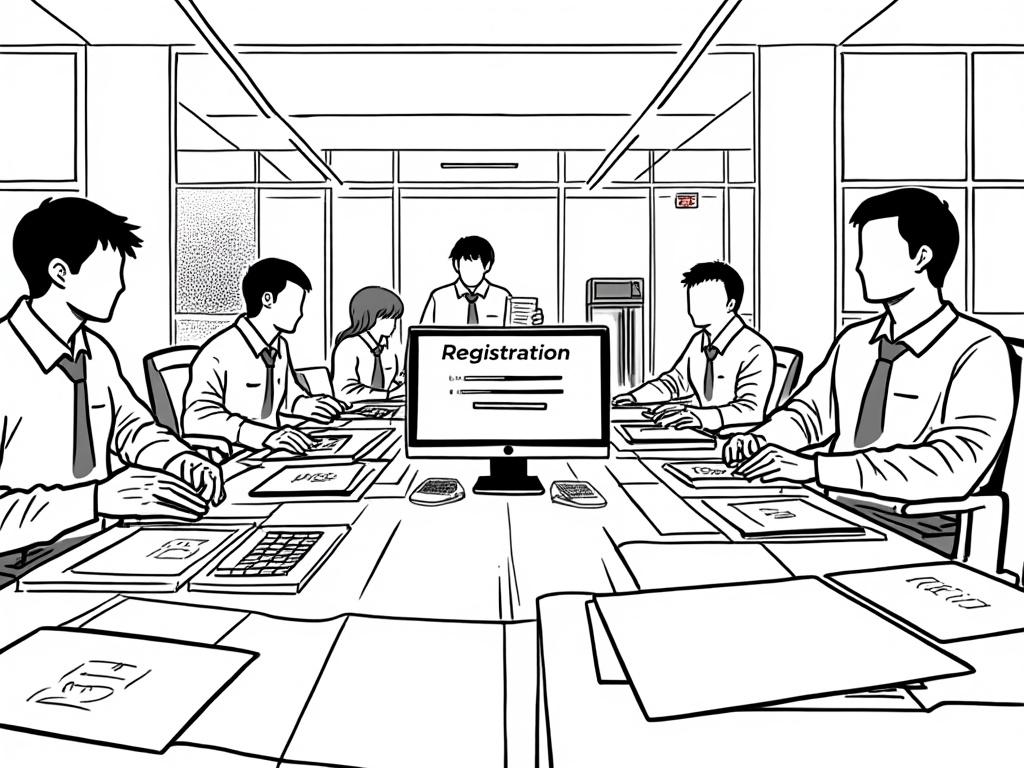
How to Renew Your Business Registration: A Step-by-Step Guide to Staying Compliant and Competitive
Reading time: 8 minutes
Table of Contents
- Why Business Registration Renewal Actually Matters
- The Strategic Preparation Phase
- Your Complete Renewal Roadmap
- Navigating Common Renewal Pitfalls
- Advanced Renewal Strategies for Smart Entrepreneurs
- When Things Go Wrong: Troubleshooting Guide
- Your Compliance Blueprint: Moving Forward
- Frequently Asked Questions
Why Business Registration Renewal Actually Matters
Ever wondered what happens when successful businesses suddenly face operational shutdowns? Often, it’s not market failure or financial struggles—it’s something as seemingly simple as an expired business registration.
Here’s the reality: Over 23% of small businesses face compliance-related penalties each year, with registration lapses being among the top causes. But renewal isn’t just about avoiding problems—it’s about maintaining your competitive edge and legal standing in the marketplace.
The True Cost of Neglect:
- Immediate operational restrictions and potential business closure
- Financial penalties ranging from $500 to $5,000 depending on jurisdiction
- Loss of business credibility with clients, vendors, and partners
- Complications with banking relationships and credit arrangements
- Potential personal liability issues for business owners
Consider this scenario: Sarah’s digital marketing agency was thriving with $2.3 million in annual revenue when her business registration quietly expired. Within weeks, her primary client—a Fortune 500 company—terminated their contract due to compliance requirements. The lesson? Proactive renewal management isn’t administrative busywork—it’s business protection.
The Strategic Preparation Phase
Building Your Renewal Timeline
Smart entrepreneurs don’t wait for renewal deadlines—they create systematic approaches that turn compliance into competitive advantage. Here’s how to build your strategic timeline:
90 Days Before Expiration:
- Review current registration status and requirements
- Assess any business changes that might affect renewal
- Budget for renewal fees and potential additional costs
60 Days Before:
- Gather required documentation and verify accuracy
- Schedule time for online portal access or office visits
- Coordinate with accountant or legal advisor if needed
30 Days Before:
- Complete renewal application and review thoroughly
- Process payment and obtain confirmation receipts
- Set up monitoring for approval status
Essential Documentation Checklist
The documentation requirements vary significantly by jurisdiction and business type, but here’s your comprehensive preparation list:
| Document Type | Sole Proprietorship | LLC/Partnership | Corporation | Notes |
|---|---|---|---|---|
| Current Registration Certificate | Required | Required | Required | Original or certified copy |
| Tax Compliance Certificate | Often Required | Required | Required | Must be current within 30 days |
| Financial Statements | Sometimes | Usually Required | Required | Audited statements preferred |
| Updated Articles/Operating Agreement | N/A | If Changed | If Changed | Only if modifications occurred |
| Registered Agent Information | Sometimes | Required | Required | Must include current address |
Your Complete Renewal Roadmap
Step 1: Portal Access and Verification
Most jurisdictions now offer online renewal systems, but navigating them effectively requires strategy. Here’s the insider approach:
Pro Tip: Create a dedicated email account for business compliance communications. This prevents important renewal notices from getting lost in your daily inbox clutter.
Before logging into any government portal:
- Verify the official website URL (scammers create fake renewal sites)
- Update your contact information in the system first
- Screenshot your current registration details for reference
- Check if your business classification or activities have changed
Step 2: The Application Deep-Dive
Here’s where most businesses make critical errors. The renewal application isn’t just a formality—it’s an opportunity to update and optimize your business profile.
Key Areas Requiring Attention:
- Business Activity Codes: Ensure these match your current operations. Incorrect codes can trigger audits or limit business opportunities.
- Revenue Reporting: Some jurisdictions use this for fee calculations. Be accurate but understand the implications.
- Employment Information: This affects various compliance requirements and potential benefits.
- Location Details: Remote work changes may require updates to registered addresses.
Step 3: Fee Structure Navigation
Understanding fee structures helps you budget effectively and avoid surprises. Here’s a breakdown of typical costs across different business scenarios:
Renewal Fee Comparison by Business Size
$150 average
$350 average
$650 average
$1,000+ average
Navigating Common Renewal Pitfalls
The Deadline Trap
Missing renewal deadlines isn’t just about late fees—it can trigger a cascade of business disruptions. Consider the case of TechStart Solutions, a growing software company that missed their renewal by just three days. The result? Their business banking account was frozen, payroll processing stopped, and they spent two weeks resolving compliance issues while losing a major client pitch.
Deadline Management Strategies:
- Set up calendar reminders at 90, 60, and 30-day intervals
- Use business management software with compliance tracking features
- Assign renewal responsibility to a specific team member with backup coverage
- Consider professional compliance services for complex multi-jurisdiction businesses
Documentation Disasters
Incomplete or incorrect documentation accounts for nearly 40% of renewal delays. Here’s how to avoid these costly mistakes:
The Document Verification Protocol:
- Cross-Reference Requirements: Don’t rely on memory—check current requirements annually
- Professional Review: Have your accountant or attorney review submissions before filing
- Digital Organization: Maintain a cloud-based compliance folder with all current documents
- Backup Planning: Keep multiple copies of essential documents in different formats
Advanced Renewal Strategies for Smart Entrepreneurs
The Compliance Audit Approach
Smart business owners use renewal periods as strategic checkpoints. Rather than viewing renewal as an administrative burden, treat it as an annual business health check.
Strategic Review Elements:
- Business Structure Optimization: Is your current entity type still optimal for tax and liability purposes?
- Regulatory Landscape Changes: Have new regulations created opportunities or risks for your business?
- Expansion Considerations: Do you need to register in additional jurisdictions?
- Compliance Integration: How can you streamline ongoing compliance processes?
Technology Integration Solutions
Modern businesses leverage technology to transform compliance from reactive to proactive management. According to recent industry data, businesses using automated compliance systems report 73% fewer regulatory issues and save an average of 12 hours per year on renewal processes.
Recommended Technology Stack:
- Compliance Management Software: Tools like CorpNet or LegalZoom for automated tracking
- Document Management Systems: Cloud-based solutions for organized record keeping
- Calendar Integration: Automated reminders tied to your business calendar system
- Financial Integration: Connect renewal costs to your budgeting and accounting systems
When Things Go Wrong: Troubleshooting Guide
Handling Renewal Denials
Renewal denials happen, but they’re not business death sentences. Here’s your strategic response framework:
Immediate Response Protocol (First 24 Hours):
- Obtain detailed denial reasons in writing
- Assess timeline for appeal or resubmission
- Identify required corrective actions
- Notify key stakeholders (banks, major clients, partners)
Resolution Strategy (Days 2-14):
- Gather additional documentation or corrections needed
- Consult with legal or accounting professionals if issues are complex
- Prepare comprehensive resubmission package
- Consider expedited processing options if available
Emergency Operating Procedures
What happens when your registration expires and you need to continue operations? Here’s your emergency playbook:
Temporary Solutions:
- File for temporary operating permits where available
- Communicate transparently with clients about resolution timeline
- Implement additional liability protections during the gap period
- Document all business activities for compliance review
Your Compliance Blueprint: Moving Forward
Successful business registration renewal isn’t just about avoiding problems—it’s about building systematic approaches that scale with your business growth. As regulatory environments become increasingly complex, the businesses that thrive are those that view compliance as a competitive advantage rather than a burden.
Your Next Action Steps:
- Audit Your Current Status: Within the next 7 days, verify your registration expiration date and create a dedicated compliance calendar with 90, 60, and 30-day reminders.
- Build Your Documentation System: Establish a digital filing system with all required documents, and schedule quarterly reviews to ensure everything stays current and accessible.
- Create Your Renewal Protocol: Document your specific renewal process, including required forms, fees, deadlines, and responsible parties. This becomes your reusable template for future renewals.
- Implement Monitoring Systems: Set up automated tracking for renewal dates, regulatory changes, and compliance requirements specific to your industry and location.
- Plan for Growth: Consider how expansion plans might affect your registration requirements, and factor compliance considerations into your strategic planning process.
The regulatory landscape will continue evolving, with increasing emphasis on digital compliance systems and real-time reporting requirements. Businesses that establish robust renewal processes now will find themselves better positioned for future regulatory changes and expansion opportunities.
What’s your biggest compliance challenge right now, and which of these strategies will you implement first to transform it from a stress point into a systematic advantage?
Frequently Asked Questions
Can I operate my business while my renewal application is being processed?
This depends on your jurisdiction and the timing of your application. Most states allow continued operations if you submit your renewal application before the expiration date, even during processing delays. However, if your registration has already expired, you may face operational restrictions. Some jurisdictions offer temporary operating permits for these situations. Always check with your local business registration office for specific guidance, and consider filing renewals 30-60 days early to avoid any gaps in coverage.
What happens if my business information has changed significantly since my last registration?
Significant changes like business structure modifications, ownership transfers, or major activity changes may require additional documentation or even a new registration rather than a simple renewal. Common triggers include changing from sole proprietorship to LLC, adding new business activities, or relocating to a different state. Contact your registration office before submitting your renewal to clarify requirements. In some cases, you may need to file amendments to your original registration before the renewal can be processed.
Are there any benefits to renewing early, and can I renew multiple years at once?
Early renewal offers several strategic advantages: avoiding last-minute rushes, ensuring uninterrupted business operations, and often securing current fee rates before potential increases. However, multi-year renewals vary by jurisdiction. Some states allow 2-3 year renewals, while others require annual submissions. Multi-year options can provide cost savings and reduce administrative burden, but they also mean you can’t easily update business information during the renewal period. Check with your specific registration authority for available options and weigh the convenience against the flexibility of annual renewals.

